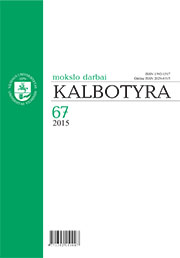Dar kartą apie intertekstualumą. Ką jis sako apie mokslinį tekstą?
Intertextuality in research writing revisited
Author(s): Rūta Petrauskaitė, Jolanta ŠinkūnienėSubject(s): Language and Literature Studies, Studies of Literature, Theory of Literature
Published by: Vilniaus Universiteto Leidykla
Keywords: intertextuality; citation indexes; citation analysis; quantitative and qualitative analysis; cross-disciplinary research;
Summary/Abstract: Intertextuality, or the link between two texts, has long been recognized as a very important part of research writing. Citations in particular have attracted much attention both from applied linguists and from bibliometricians. Citation indexes have now become an inseparable part of research evaluation which, in its turn, plays the key role in research funding. It is hardly surprising, therefore, that evaluation based on citation indexes as the main criteria for financing and scientific awards has received a widespread dissatisfaction, primarily because it often fails to take into account the breadth and variety of disciplinary approaches. In order to shed light on citation practices and their suitability for research evaluation, scientists have been approaching citations from both scientometric and linguistic perspectives. Much has been done in the field, including research on self-citation and its impact on citation indexes, a variety of attempts to classify citations, sentiment analysis for citation polarity and automatic citation strength estimation, inter alia. Most of these works, however, are based on data from one discipline or compare two clearly contrasting science areas, such as the so called “hard” and “soft” sciences. There are far less studies that offer an indepth view of how citation works in closer disciplines as well as in research cultures other than English. Based on two PhD dissertations written by Lithuanian young scholars in sociology and cultural studies, this paper analyzes a variety of quantitative and qualitative citation aspects, such as citation density, year of publication and its type, integral/non integral distinction, level of detail, number of citations at one reference point, type & token ratio adapted to citations, the distribution of citations in theoretical and practical parts of the dissertations. The results reveal clear disciplinary differences in the use of citation. The cultural studies dissertation uses more direct quotes than the sociology dissertation, with integral references dominating and thus allowing to place more emphasis on the cited author rather than on the information. Conversely, non-integral referencing prevails in the sociology dissertation with less detailed reference to sources used. Books are the most popular type of reference source in the cultural studies dissertation, while the sociology dissertation relies more on research articles. If automatized, the analytical model adopted in this paper could serve as a fast and useful tool for the initial evaluation of student papers, research articles submitted to research journals, etc. The citation patters of a new work can be matched against prevailing citation trends in the discipline and reveal how adequately the new work is embedded in literature.
Journal: Kalbotyra
- Issue Year: 2015
- Issue No: 67
- Page Range: 67-85
- Page Count: 19
- Language: Lithuanian

